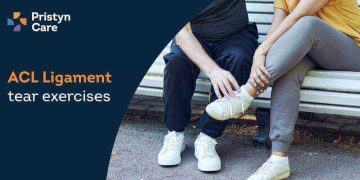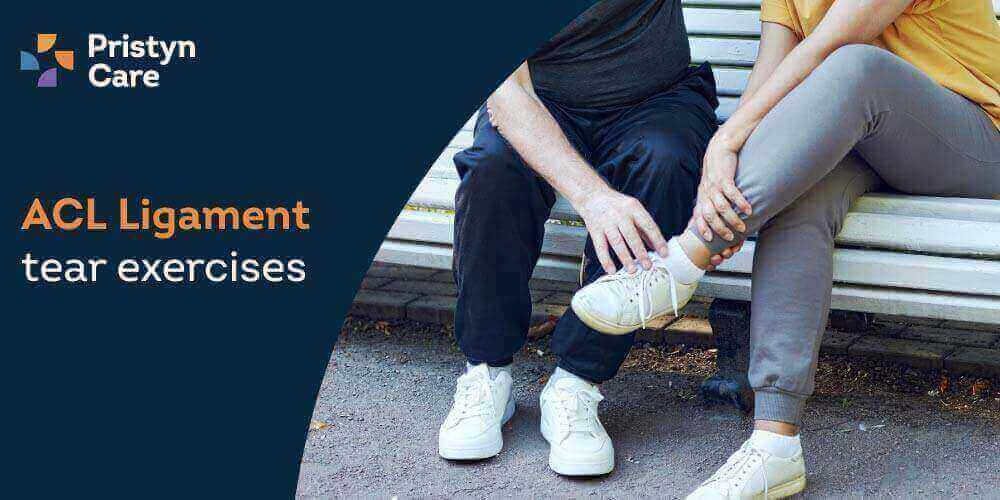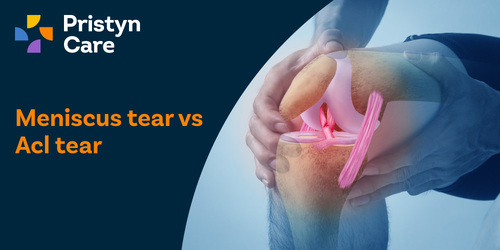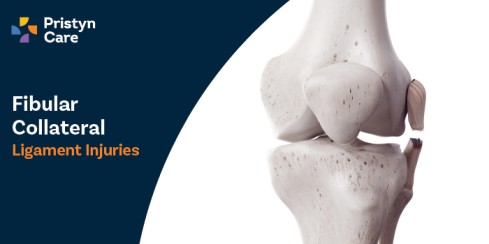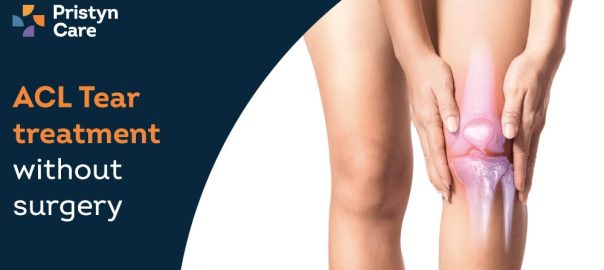![]() Views: 61
Views: 61
ACL Ligament Tear Exercises
These exercises aren’t just a step toward healing; they’re a pathway to reclaiming your mobility and getting back to the sports and activities you love.
Dedicated Support at Every Step!
Our Doctors are available 24 hours a day, 7 days a week to help you!
Call Us9513-316-643Curious about how you can accelerate your recovery and regain your confidence? In this article, we will take a look at the basic overview along with the exercises that can make a real difference in your journey to full recovery.
Table of Contents
ACL Ligament Tear | Overview
The ACL (anterior cruciate ligament) is a key ligament in the knee that helps stabilise the joint during movement. An ACL tear often occurs from a sudden twist or impact, commonly seen in sports like football, basketball, or skiing. When the ACL is torn, it can cause pain, swelling, and a feeling of instability in the knee.
Depending on the severity, the tear might be partial or complete, affecting your ability to walk or run. While surgery is sometimes required, many people recover with a combination of rest, physical therapy, and targeted exercises. Understanding the basics of an ACL tear is essential for effective treatment and a successful recovery.
No Cost EMI, Hassle-free Insurance Approval
Best ACL Ligament Tear Exercises: A Pathway to Recovery
Recovering from an ACL ligament tear can be a challenging journey, but the right exercises can make all the difference in rebuilding strength and stability in your knee. These exercises are designed to enhance muscle function, restore balance, and support your knee as it heals.
Below are the seven essential exercises that can help you regain mobility and confidence.
1. Heel Slides
Heel slides are a gentle exercise that helps improve knee mobility and flexibility, especially in the early stages of recovery. This exercise helps prevent stiffness in the knee joint and promotes circulation to aid the healing process. It’s an excellent way to begin moving the knee without putting too much strain on it.
Steps to Do the Exercise:
- Lie flat on your back on a comfortable surface, ensuring your legs are fully extended.
- Slowly slide the heel of your injured leg toward your buttocks, bending the knee gradually.
- Hold the position for 5-10 seconds, feeling the stretch in your knee, then gently slide the heel back to the starting position.
- Perform 15-20 repetitions, focusing on smooth, controlled movements without forcing the knee.
2. Quad Sets
Quad sets target the quadriceps muscles, which are crucial for knee stability and function after an ACL tear. This exercise helps maintain muscle tone during recovery, preventing muscle atrophy while your knee is healing. It also plays a significant role in regaining the ability to straighten the knee fully.
Steps to Do the Exercise:
- Sit with your injured leg straight in front of you and the other leg bent comfortably.
- Press the back of your knee down into the floor by tightening your quadriceps muscle. Imagine pushing the knee cap downwards.
- Hold the contraction for 10-15 seconds, keeping the muscles engaged.
- Release and repeat the exercise 15-20 times, ensuring each contraction is strong and controlled.
3. Straight Leg Raises
Straight leg raises strengthen the quadriceps without putting excessive stress on the knee joint. This exercise is particularly useful in the early stages of recovery, as it enhances muscle strength without requiring knee movement. It also helps improve your ability to lift the leg, which is essential for walking.
Steps to Do the Exercise:
- Lie on your back with one leg bent and the other leg (the injured one) straight on the floor.
- Tighten your quadriceps, then slowly lift the straight leg until it reaches the height of the bent knee.
- Hold the position for 5 seconds, then slowly lower the leg back to the ground with control.
- Complete 15-20 repetitions, and make sure the lifting motion is steady and the leg remains straight throughout.
4. Hamstring Curls
Hamstring curls focus on strengthening the hamstrings, which help stabilise the knee during movement. Strengthening these muscles can improve your ability to bend the knee and protect it from further injury. This exercise is beneficial for restoring balance between the muscles at the front and back of your thigh.
Steps to Do the Exercise:
- Stand upright with your feet hip-width apart, using a chair or wall for support if needed.
- Slowly bend your knee, bringing your heel toward your buttocks without moving your upper body.
- Hold the curl for 5 seconds, feeling the contraction in your hamstring, then slowly lower the leg back down.
- Perform 15-20 repetitions, focusing on smooth, deliberate movements and avoiding jerky motions.
5. Calf Raises
Calf raises strengthen the calf muscles, which play a supportive role in knee stability. These muscles help control foot movements, which in turn reduces strain on the knee. Strong calves also contribute to better balance and support for daily activities like walking and climbing stairs.
Steps to Do the Exercise:
- Stand with your feet parallel and shoulder-width apart, near a wall or sturdy surface for balance.
- Slowly rise onto the balls of your feet, lifting your heels as high as possible while keeping your knees straight.
- Hold the raised position for 5 seconds, focusing on engaging your calf muscles, then slowly lower your heels back to the floor.
- Repeat this exercise 15-20 times, and your movements should be controlled and avoid leaning forward or backward.
6. Wall Sits
Wall sits help build strength in the quadriceps and glutes, which are essential for knee support. This exercise is an excellent way to engage multiple muscle groups simultaneously, providing overall leg stability. It also mimics the action of sitting down and standing up, which is crucial for everyday activities.
Steps to Do the Exercise:
- Stand with your back flat against a wall, feet about two feet away from the wall and shoulder-width apart.
- Slowly slide down the wall until your knees are at a 90-degree angle, as if you are sitting in a chair.
- Hold the position for 20-30 seconds, ensuring your back remains in contact with the wall and your knees don’t extend past your toes.
- Gradually slide back up to the starting position and repeat the exercise 10-15 times, increasing the hold time as you build strength.
7. Side-Lying Leg Lifts
Side-lying leg lifts target the hip abductors, which help stabilise the knee during lateral movements. Strengthening these muscles can prevent knee valgus (inward collapse), a common issue following ACL injuries. This exercise also improves hip stability, which is crucial for overall leg alignment.
Steps to Do the Exercise:
- Lie on your side with your injured leg on top, keeping both legs straight and your lower arm under your head for support.
- Slowly lift your top leg upward, keeping it straight and avoiding any rotation of the hip.
- Hold the lifted position for 5 seconds, focusing on the contraction in your hip muscles, then slowly lower the leg back down.
- Repeat 15-20 times, ensuring the lift is controlled and the leg doesn’t drop quickly.
Conclusion
The process of recovering from an ACL ligament tear may seem overwhelming at first, but with the right exercises you will begin to regain your strength and confidence. These exercises are not just about healing; they’re about empowering you to return to the activities you love with a stronger, more stable knee.
Consistency and patience are your allies in this journey. Always consult with your healthcare provider to ensure these exercises align with your recovery plan, paving the way for a full and active recovery.
Frequently Asked Questions
Q1. How long does it take to recover from an ACL tear?
Recovery time varies but typically ranges from 6 to 12 months. Factors like the severity of the tear, surgery, and rehabilitation commitment play a role. Following a tailored exercise program can significantly speed up the healing process.
Q2. Can you walk with a torn ACL?
While it’s possible to walk with a torn ACL, the knee may feel unstable and painful. Walking without proper support can worsen the injury. It’s crucial to follow medical advice and avoid strenuous activities until recovery progresses.
Q3. Is surgery always necessary for an ACL tear?
Surgery isn’t always required for an ACL tear. Mild tears may heal with physical therapy and exercises, but severe or complete tears often need surgical intervention to restore knee stability and prevent further injury.
Q4. What are the signs of a successful ACL recovery?
Signs of successful recovery include the return of knee stability, full range of motion, and the ability to perform daily activities without pain. Strength and flexibility improvements are also key indicators of progress.
Q5. Can I prevent future ACL injuries?
Yes, you can prevent future ACL injuries by maintaining strong leg muscles, improving balance and coordination, and practising proper techniques during sports. Regularly performing ACL strengthening exercises is also essential for prevention.
Q6. How soon after ACL surgery can I start exercises?
Exercises typically begin within a few days to a week after ACL surgery, starting with gentle movements. Your healthcare provider or physical therapist will guide you through a progressive exercise plan tailored to your recovery.
Q7. What should I avoid during ACL recovery?
Avoid high-impact activities, sudden movements, and exercises that strain the knee, such as running or jumping, during the early recovery phase. It’s important to follow your physical therapist’s advice to prevent setbacks.
Q8. Can I return to sports after an ACL tear?
Yes, many people return to sports after an ACL tear with proper rehabilitation. However, it’s essential to regain full strength, stability, and confidence in your knee before resuming high-impact activities.
Q9. What role does diet play in ACL recovery?
A balanced diet rich in protein, vitamins, and minerals supports tissue repair and overall recovery. Staying hydrated and avoiding excessive sugar or processed foods can also contribute to faster healing and improved strength.
Q10. How do I know if my ACL exercises are effective?
Effectiveness is indicated by gradual improvement in knee strength, flexibility, and stability. Reduced pain and increased confidence in performing daily activities without discomfort also suggest that the exercises are beneficial. Regular assessments by a physical therapist can confirm progress.



